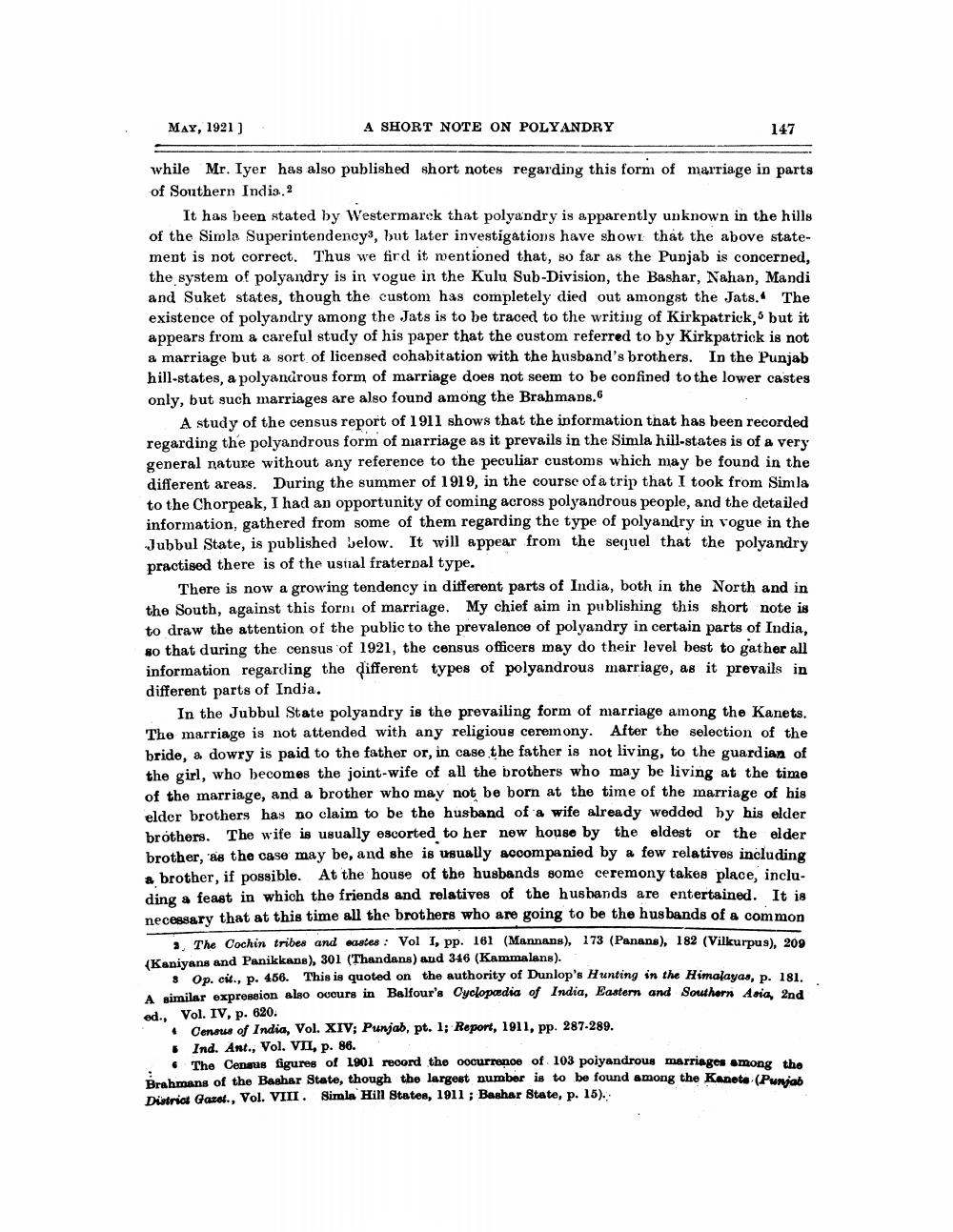________________
MAY, 1921)
A SHORT NOTE ON POLYANDRY
147
while Mr. Iyer has also published short notes regarding this form of marriage in parts of Southern Indis.
It has been stated by Westermarek that polyandry is apparently unknown in the hills of the Simola Superintendency, but later investigations have shown that the above statement is not correct. Thus we fird it mentioned that, so far as the Punjab is concerned. the system of polyandry is in vogue in the Kulu Sub-Division, the Bashar, Nahan, Mandi and Suket states, though the custom has completely died out amongst the Jats. The existence of polyandry among the Jats is to be traced to the writing of Kirkpatrick, but it appears from a careful study of his paper that the custom referred to by Kirkpatrick is not a marriage but a sort of licensed cohabitation with the husband's brothers. In the Punjab hill-states, a polyandrous form of marriage does not seem to be confined to the lower castes only, but such marriages are also found among the Brahmaps.
A study of the census report of 1911 shows that the information that has been recorded regarding the polyandrous form of marriage as it prevails in the Simla hill-states is of a very general nature without any reference to the peculiar customs which may be found in the different areas. During the summer of 1919, in the course of a trip that I took from Simla to the Chorpeak, I had an opportunity of coming across polyandrous people, and the detailed information, gathered from some of them regarding the type of polyandry in vogue in the Jubbul State, is published below. It will appear from the sequel that the polyandry practised there is of the usual fraternal type.
There is now a growing tendency in different parts of India, both in the North and in the South, against this forni of marriage. My chief aim in publishing this short note is to draw the attention of the public to the prevalence of polyandry in certain parts of India. so that during the census of 1921, the census officers may do their level best to gather all information regarding the different types of polyandrous marriage, as it prevails in different parts of India.
In the Jubbul State polyandry is the prevailing form of marriage among the Kanets. The marriage is not attended with any religious ceremony. After the selection of the bride, a dowry is paid to the father or, in case the father is not living, to the guardian of the girl, who becomes the joint-wife of all the brothers who may be living at the time of the marriage, and a brother who may not be born at the time of the marriage of his elder brothers has no claim to be the husband of a wife already weddod by his elder brothers. The wife is usually escorted to her new houso by the eldest or the elder brother, as the case may be, and she is usually accompanied by a few relatives including a brother, if possible. At the house of the husbands some ceremony takes place, including a feast in which the friends and relatives of the husbands are entertained. It is necessary that at this time all the brothers who are going to be the husbands of a common
The Cochin tribes and scales : Vol I, pp. 161 (Mannans), 173 (Panans), 182 (Vilkurpus). 209 (Kaniyans and Panikkans), 301 (Thandans) aud 346 (Kammalans).
8 Op. cit., p. 456. This is quoted on the authority of Dunlop's Hunting in the Himalayas, p. 181. A similar expression also ocours in Balfour's Cyclopaedia of India, Eastern and Southern Asia. 2nd ed., Vol. IV, p. 620.
Census of India, Vol. XIV; Punjab, pt. 1; Report, 1911, pp. 287-289. • Ind. Ant., Vol. VII, p. 86.
6 The Census figures of 1901 record the oocurrence of 103 poiyandrous marriages among the Brahmans of the Bashar State, though the largest number is to be found among the Kaneto (Punjab District Gazet., Vol. VIII. Simla Hill States, 1911; Bashar State, p. 15).




